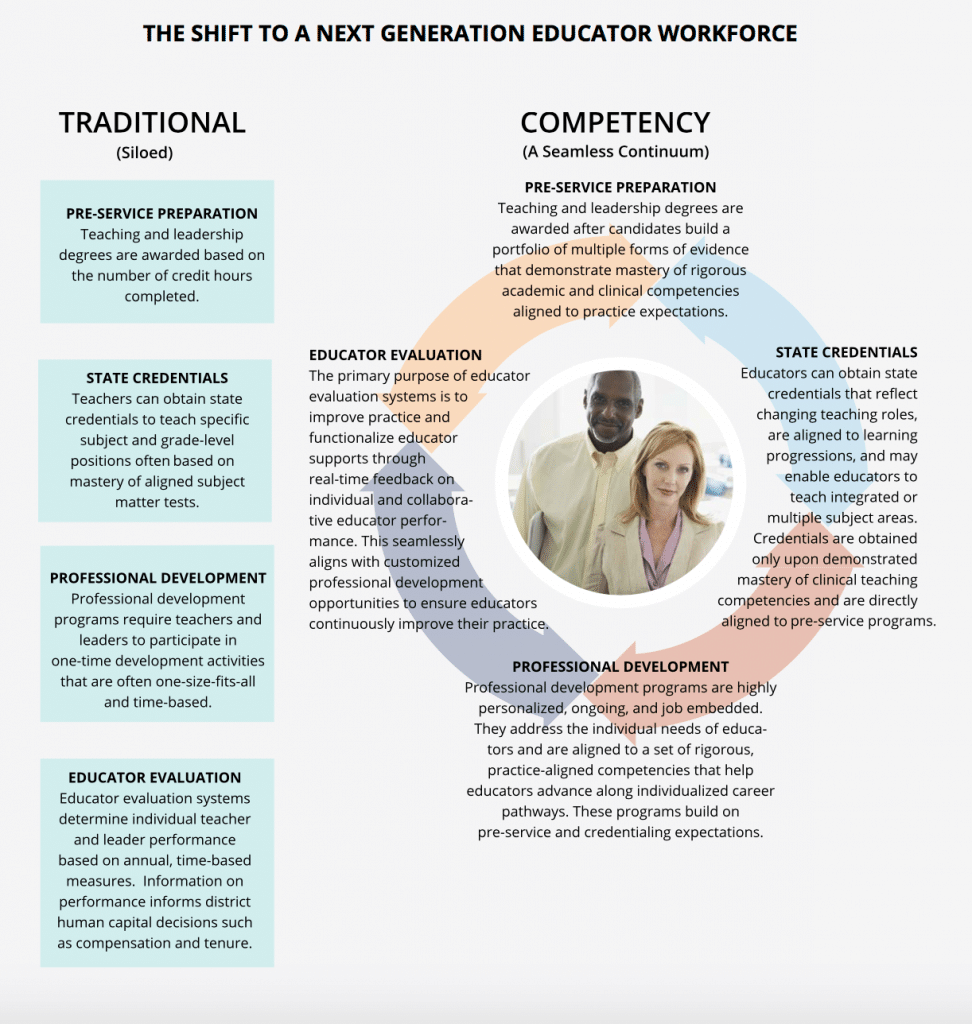Building Educator Capacity to Personalize Learning for Every Student
Education Domain Blog
Only by raising and building the capacity of educators and school leaders will we realize the bold vision of systemic transformation toward student-centered learning. Educators across the K-12 education workforce are the most important element of success in the shift to powerful, personalized, competency-based learning.
To make this a reality, state leaders need to modernize educator preparation to become competency-based and personalized. They ought to transform their siloed educator preparation, certification, development and evaluation systems into an integrated, coherent and aligned system designed to build capacity within educators to effectively implement personalization at scale.
In student-centered learning, educators and leaders take on new roles as they work individually and collectively to design customized pathways to graduation for every student. Most educators will require new skills to adapt instruction for students with varying levels of competency and interests. This will require significant changes to ensure educators have the support and resources they need to make this transition.
State leaders should collaborate with stakeholders to create a cohesive vision for transforming the educator workforce to support a new definition of student success.
The graphic below from the iNACOL and KnowledgeWorks report, Laying the Foundation for Competency Education: A Policy Guide for the Next Generation Workforce, contrasts the traditional educator workforce system with a seamless, next-generation system able to prepare educators at scale to effectively personalize learning for every student.

Educator Preparation and Credentialing
Transformation of the educator workforce must begin with development of educator standards and competencies which reflect the skills and professional responsibilities educators will need to transition to competency-based instruction.
A next generation education system will align pre-service and credentialing programs to ensure educators can succeed in competency-based learning environments through the following:
- Pre-service programs and credentialing requirements should align to instructional competencies that will ensure educators have the knowledge and skills needed to help all students excel in a competency-based system;
- Accreditation requirements for teacher preparation programs should also align to instructional competencies which educator candidates earn based on mastery, not seat time; and
- Educator preparation programs should provide candidates with multiple pathways to completion, ensuring mastery of the full-range of instructional competencies, and candidates should have various ways to attain competency-based licensure.
States should engage a wide range of stakeholders in this conversation around the future of educator preparation and credentialing, including educators from across the K-12 system, as well as representatives from pre-service preparation programs and state educational agencies.
Until recently, federal teacher requirements focused almost exclusively on input-based credentials like Highly Qualified Teacher (HQT). HQT provisions were repealed with the passage of the Every Student Succeeds Act (ESSA)—an important first step. The flexibility now provided by the federal government is a call to action for states to shape their own systems. Thus, it will be up to each state to lead the critical next step: shifting the focus to educator competencies as the basis for credentialing on demonstrated outcomes, rather than on time-based inputs.
With ESSA’s new flexibility, state policy could change to support teachers earning portable recognitions of mastery, such as stacked micro-credentials or digital badges.
The MacArthur Foundation explains that “badges are designed to make visible and validate learning in both formal and informal settings, and hold the potential to help transform where and how learning is valued.”
Teachers and school leaders build capacity for personalized learning by experiencing it and demonstrating mastery of competencies using evidence such as projects, exhibitions, e-portfolios and work products. Educators could experience professional development by creating powerful, personalized learning experiences.
States, districts and schools should work together to create next generation micro-credentials to redesign teacher preparation and certification for the 21st century.
Educator Professional Development and Evaluation
New competency-based professional development pathways are also necessary to build strong pipelines of bold, visionary and capable school and district leaders to catalyze the transformation to next generation learning.
States can build capacity in educators and school leaders to create new, personalized models of instruction, by creating ongoing professional development programs where educators can constantly apply what they are learning on the job and continually refine their practice. One key area will be to build educator professional judgment and capacity to reliably create, grade and evaluate performance tasks within new systems of assessments that support personalized learning.
Professional learning for educators in the future will model competency-based learning with demonstrated performance and outcomes. Teachers, just like their students, should experience powerful, personalized learning experiences generating evidence of success through exhibitions and e-portfolios.
Finally, state leaders can align state requirements for educator evaluation systems to personalized, competency-based learning by:
- Emphasizing multiple measures and portfolios of evidence tied to practice;
- Encouraging teams of educators to work collaboratively to ensure students are progressing to or above grade level;
- Supporting local leaders and educators toward data-driven instructional and evaluation systems with multiple measures; and
- Evaluating the state’s role in building educator capacity for continuous improvement throughout the system.
Educators should receive ongoing feedback on the impact of instructional strategies so they can make the necessary adjustments in real time to ensure all students are on pace to be college- and career-ready upon graduation. It is important to consider what is the appropriate state and local role and determine which data are needed by each to meet policy objectives and foster continuous improvement toward a learner-centered education system.
Transformed Systems for a Next Generation Workforce
As state policymakers work to transform the educator and school leader workforce, they should take care to ensure systems of support—from pre-service through credentialing, professional development and evaluation—are integrated, coherent and aligned.
Our educators deserve personalized pathways to support and effectively lead the transformation of the K-12 system to personalized, competency-based education. With the passage of ESSA, these opportunities are firmly in the domain of state policy and provide one of the biggest policy opportunities for systemic transformation.
State Policy Recommendations
- Create seamless, aligned and coherent educator and school leader preparation and development systems by:
- Engaging a wide range of stakeholders to develop competencies that align to the state’s academic standards and reflect the skills needed for personalized, competency-based learning environments;
- Aligning teacher and leader preparation program accreditation requirements to these competencies;
- Providing educator candidates with multiple pathways to attaining competency-based credentials;
- Using micro-credentials as the basis of new competency-based educator credentials and in lieu of seat-time-based Continuing Education Unit requirements for professional development;
- Creating ongoing, job-embedded professional development to build capacity in educators and school leaders to transition to new, personalized models of instruction; and
- Aligning state requirements for educator evaluation systems to support personalized, competency-based learning.
This is the sixth blog in a series to highlight state policy recommendations to create a foundation for sustainable, systemic change that will dramatically increase personalized, competency-based learning opportunities for all students.
Learn more:
- iNACOL Report – Promising State Policies for Personalized Learning
- iNACOL Report – Laying the Foundation for Competency Education: A Policy Guide for the Next Generation Workforce
- iNACOL Blog – Modernizing Educator and Leader Development for Student-Centered Learning
- iNACOL Blog – How States Build Local Capacity to Implement Personalized Learning
